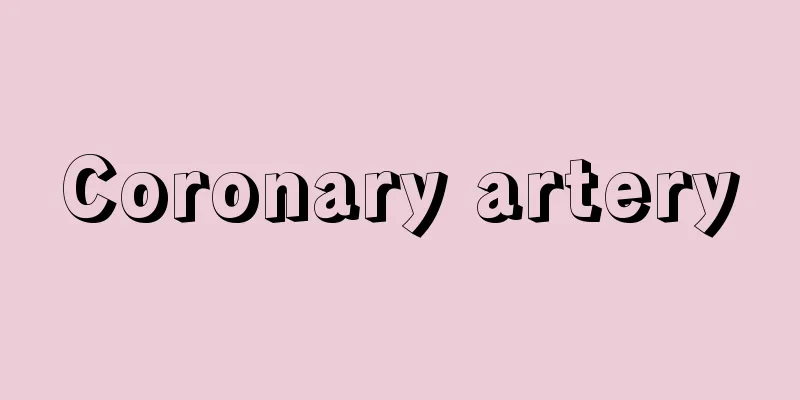Coronary artery

|
The two arteries that provide nutrition to the heart muscle (myocardium), also called the coronary arteries, are so named because they run in a crown-like shape around the border between the ventricles and the atria. There are the right and left coronary arteries. The right coronary artery branches off just above the right aortic semilunar valve at the base of the aorta, and branches out in a clockwise direction around the border between the right atrium and the right ventricle toward the back of the heart, sending blood to the right atrium and both ventricles. The left coronary artery is slightly thicker than the right coronary artery, branches off above the left aortic semilunar valve, and branches out to the front and back of the left ventricle, sending blood to both ventricles and the left atrium. The left and right ventricles receive blood from the left and right coronary arteries in this way, but the left ventricle receives more blood than the right ventricle. This is because the left ventricle has the greatest workload. The left and right atria receive blood by branches coming out of different coronary arteries. What is important from a clinical perspective is that there are only a few anastomoses (communicating branches) between the terminal branches of the left and right coronary arteries, and blood circulation disorders in the branches of the coronary arteries cause myocardial damage in the areas controlled by those branches, which is often fatal to the heart. However, it is said that anastomotic branches that exist between small arteries develop new collateral anastomotic branches (anastomotic branches that are not normally functioning) in response to blood circulation disorders. In about 50% of human hearts, the left and right coronary arteries are equally developed, but there are also cases where the development of the left and right coronary arteries is significantly different. The amount of blood flowing through the coronary arteries is equivalent to about 5% of the total body blood volume exiting the aorta. The coronary arteries are expanded by the sympathetic nerves and contracted by the vagus nerves. [Kazuyo Shimai] [References] | |©Shogakukan "> Heart morphology, arterial system, and blood flow direction Source: Shogakukan Encyclopedia Nipponica About Encyclopedia Nipponica Information | Legend |
|
心臓の筋(きん)(心筋)の栄養をつかさどる2本の動脈で、冠動脈ともいい、心室と心房の境を冠状に取り巻いて走るのでこの名がある。冠状動脈には、右冠状動脈と左冠状動脈がある。右冠状動脈は大動脈の付け根にある大動脈右半月弁のすぐ上部から分かれ、右心房と右心室との境を心臓の後面に向かって右回りに帯状に走りながら枝を出し、右心房や両心室に血液を送る。左冠状動脈は右冠状動脈よりやや太く、大動脈左半月弁の上部から分かれ、左心室の前面と後面とに枝を出し、両心室や左心房に血液を送る。左右の心室は、このように左右の冠状動脈から血液を送られるが、左心室の受ける血液量のほうが右心室よりも多い。これは、左心室がもっとも仕事量が多いことによる。左右の心房の場合は、それぞれ別の冠状動脈から出る小枝によって血液を送られている。 臨床上重要なことは、左右冠状動脈の終末枝の間にはわずかの吻合(ふんごう)(交通枝)しかないことで、冠状動脈の枝の血行障害はその枝の支配領域の心筋障害をおこし、心臓にとって致命的となることが多いということである。しかし、小さい動脈間に存在する吻合枝は、血行障害に対しては、新しい側副吻合枝(通常では働いていない吻合枝)が発達するといわれる。ヒトの心臓の約50%は左右冠状動脈が同じ程度に発達しているが、左右冠状動脈の発達が著しく異なる場合もある。冠状動脈を流れる血液量は大動脈から出る全身の血液量の約5%に相当する。冠状動脈は交感神経によって拡張をおこし、迷走神経によって収縮する。 [嶋井和世] [参照項目] | |©Shogakukan"> 心臓の形態、動脈系、血流方向 出典 小学館 日本大百科全書(ニッポニカ)日本大百科全書(ニッポニカ)について 情報 | 凡例 |
<<: Ring peeling - Kanjohakuhi (English spelling) ringing
Recommend
Gakkihen - Gakkihen
…His research on the Book of Songs was passed on ...
Ocherk (English spelling)
A genre of prose in Russian literature. It is tran...
Calabria (English spelling)
A region in southern Italy. It has an area of 15...
Accompanying people - Shobanshu
〘Noun〙 (also "Shobanshu") People who par...
Vientiane (English spelling)
The capital of Laos. It is located in the west of ...
Magnolia coco (English spelling) Magnolia coco
…[Kunihiko Ueda]. … *Some of the terminology that...
Negative catalyst
A substance that acts on a reaction system to slow...
Psychological novel
A novel that focuses on the inner workings of a p...
Kawaratake - Kawaratake
A mushroom of the family Polyporaceae, order Poly...
Commuter
...However, as the population continues to concen...
Ismail Square - Ismail Square
...The old city is home to hundreds of mosques, i...
Rice soup - Omoyu
〘Noun〙 (meaning " rice porridge" ) The l...
Milyutin, Dmitrii Alekseevich
Born: July 10, 1816, Moscow [Died] February 7, 191...
Cadmium yellow
A pale yellow to orange-yellow inorganic pigment c...
Paget's disease
...This self-examination should be done each mont...









